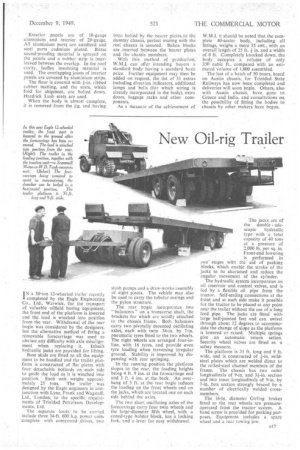New Oil-rig Trailer
Page 51

If you've noticed an error in this article please click here to report it so we can fix it.
I N a 30-ton 12-wheeled trailer recently
completed by the Eagle Engineering Co., Ltd., Warwick, for the transport of valuable oilfield boring equipment, the front end of the platform is lowered and the load is winched into positron from the rear. Withdrawal of the rear bogie Was considered by the designers, but the alternative method of fitting a removable forecarriage. was used to obviate any difficulty with axle misalignment when replacing it. Inbuilt hydraulic jacks are provided for lifting.
Base skids are fitted to all the equipment to be handled and the trailer platform is constructed of flat plates with four detachable bollards on each side to guide the load as it is winched into position. Each unit weighs approximately 25 tons. The trailer was designed by the Eagle engineers in conjunction with Lyne, Frank and Wagstaff, Ltd., London, to the specific requirements of Trinidad Petroleum Developments, Ltd.
The separate loads to be carried include three 34-ft. 600 .hp. power units complete with comround drives, two slush pumps and a draw-works assembly of eight pieces. The vehicle may also be used to carry the tubular casings and the pylon structure.
The rear bogie incorporates two " balancers " on a transverse shaft, the brackets for which are solidly attached to the chassis frame. Both balancers carry two pivotally mounted oscillating axles, each with twin 34-in. by 7-in.. pneumatic tyres fitted to the two wheels. The eight wheels are arranged four-inline, with 16 tyres, and provide even tyre loading when traversing irregular ground. Stability is improved by dispensing with rear springing.
In the running position the platform slopes to the rear, the loading heights being 4 ft. 9 ins, at the forecarriage end and 3 ft. 4 ins, at the back. An overhang of 3 ft. at the rear bogie reduces the loading on the front wheels and on the jacks, which are located one on each side behind the axles, The two short oscillating axles of the forecarriage carry four twin wheels and the large-diameter fifth wheel, With a coned-type bolster block, has a locking fork, and a lever for easy withdrawal. The jacks are of
the double telescopic hydraulic type with a total capacity of 40 tons at a pressure of 2,000 lb. per sq. in. Front-end lowering is performed in two stages with the aid of packing blocks, which enable the stroke of the jacks to be shortened and reduce the angular movement of the cylinder.
The hydraulic system incorporates an oil reservoir and control valves, and is fed by a flexible oil pipe from the tractor. Self-sealing connections at the front and at each side make it possible for the tractor to be placed at any point near the trailer without the use of a long feed pipe. The jacks are fitted with large ball-jointed feet and can swivel through about 12 degrees to accommodate the change of slope as the platform is lowered or raised. Multiple springs give an automatic return action. Security wheel valves are fitted as a safety measure.
The platform is 31 ft. long and 9 ft. wide, and is constructed of g-in. mildsteel plates which are welded direct to the rolled-steel channel members of the frame. The chassis has two outer longitudinals of 9-in. and 3fin. section and two inner longitudinais of 9-in. by 7-in, box section strongly braced by a number of electrically welded crossmembers.
The 16-in, diameter Girling brakes fitted to the rear wheels are pressureoperated from the tractor system. A hand screw is provided for parking purposes. Equipment includes a spare wheel and a rear towing jaw.




























































































